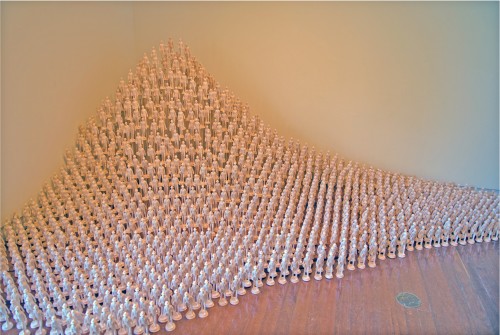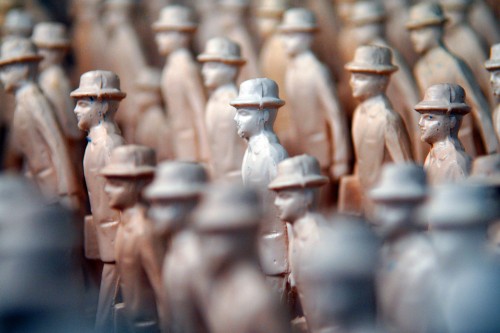When I interview an artist for radio format, I go in hoping for interesting and honest statements about his/her work and ideas, because I know that in the editing suite, I’m going to have to be economical. If an artist can succinctly (so little air time, people!) express something original, and thought-provoking about his or her work, I find a way for the clip to make the cut. And yet, although I hate to admit it, with the occasional artist, this requires me having to wade through rehearsed grant-speak that they’ve plucked verbatim from their artist statements. So when I sat down recently with Canadian artist, Scott Yoell, after his exhibition as part of The Contemporary Museum Biennial of Hawai’i Artists, I was delighted that he spoke candidly, from the heart, about his work. Already, Yoell’s Biennial-presented conceptual work entitled Tsunami elicits a lingering cerebral response that continues to cause you to think about it long after you’ve seen it. And an hour-long conversation with him about the work revealed even more layers of philosophical connections to the work and the artist who made it.

Scott Yoell, "Tsunami," installation view, 2010. Courtesy the artist and The Contemporary Museum Honolulu.

Scott Yoell, "Tsunami," installation view, 2010. Courtesy the artist and The Contemporary Museum Honolulu.
Tsunami is an installation work that consists of three thousand, four-inch tall businessman figures cast in flesh-toned plastic. Each man wears a hat and carries a briefcase. The mass of the figures together forms what appears to be a surge of water, a tsunami — the whole of the formation is more overwhelming than the small parts that devise it, no one figure able to resist the swell of what is naturally unstoppable. The scale of the work – too many replicas to count – is a brash statement in itself. In our capitalism-critiquing era post-Naomi Klein’s No Logo, a glib comment discrediting obtuse representations of mass production might be expected here, but Yoell’s work is more complex. With a background of training in sculpture, Yoell’s own handiwork went into the fabrication of each figurine; the mold that he employed to create each figure deteriorated with every use in the art-making process, and so despite the result of general uniformity among the men, each one is slightly individualized and imperfect, different though undetectably so. The work is metaphorically-rich to say the least, but its origins are perhaps the most interesting aspect to me.

Scott Yoell, "Tsunami," installation view, 2010. Courtesy the artist and The Contemporary Museum Honolulu.
According to Yoell, Tsunami was first conceived of almost a decade ago when the artist happened upon “a trinkety figure, a little metal business man” in a shop in Omaha, Nebraska. The man reminded Yoell of the small figures that sit atop sports trophies. But what did a suited man celebrate? What did he stand to champion? Fascinated by the unknown original purpose for which the suited mini-man could have been fabricated, Yoell bought the figure and hung onto it, as well as the ideas that would stem from it, for years to come. Yoell tells me he worked intuitively, and let his research and play with materials develop symbiotically, until the metal figure would be the cataclysm for a larger idea almost a decade later. After a move to the island of Hawaii, the figure of the man emerged again and from him, the idea of Tsunami, but not after Yoell exhausted his research process exploring island life, the seemingly backwards notion of agricultural importation in Hawaii, as well as the emergence of a new social class in 1950s America.
So how does a Canadian come to make a work that sounds like it’s about life in America? Maybe it isn’t. Tsunami may be about personal experience with land, as much as it is about global economy. In Hawaii, news about tsunami warnings are real and can rattle geography and economy alike. With his complex installation work, Yoell may be dealing with the question of how to talk about our world without reducing it to universals. Yoell asserts himself in a non-national culture that values intellectual inquiry.
A Canadian transplant from Windsor, Ontario, who married a Hawaiian resident whom he met while both lived and practiced art in Montréal, Yoell now calls Honokaa, Hawaii home. It seems living experiences in both these places (among many others), along with Yoell’s self-proclaimed fascination with trinkets – objects which selectively turn traditional cultural items into kitsch toys – collide in Tsunami. I think of how Yoell found his original modeled cast man, and wonder whether he is inadvertently drawing connections between the manufactured Hawaiian “culture” rife on the island crawling with tourists, and the equivalent of First Nations’ cultures in Ontario and elsewhere in Canada whose traditions have come to be signified by expensive ‘native’ dolls, and ‘Indian’ prints in tourist shops across the country. Political engagement in public discourse on indigenous issues could potentially take many more (and diverse) forms than it already does. In hearing from the artist how much consideration – concept, research, and labor – were involved in the process of creating “Tsunami” it seems Yoell has found his method of participating in post-colonial discourse.





Pingback: Tweets that mention Calling From Canada: Scott Yoell’s “Tsunami” | Art21 Blog -- Topsy.com
Pingback: Art:21 Review | AGGROculture